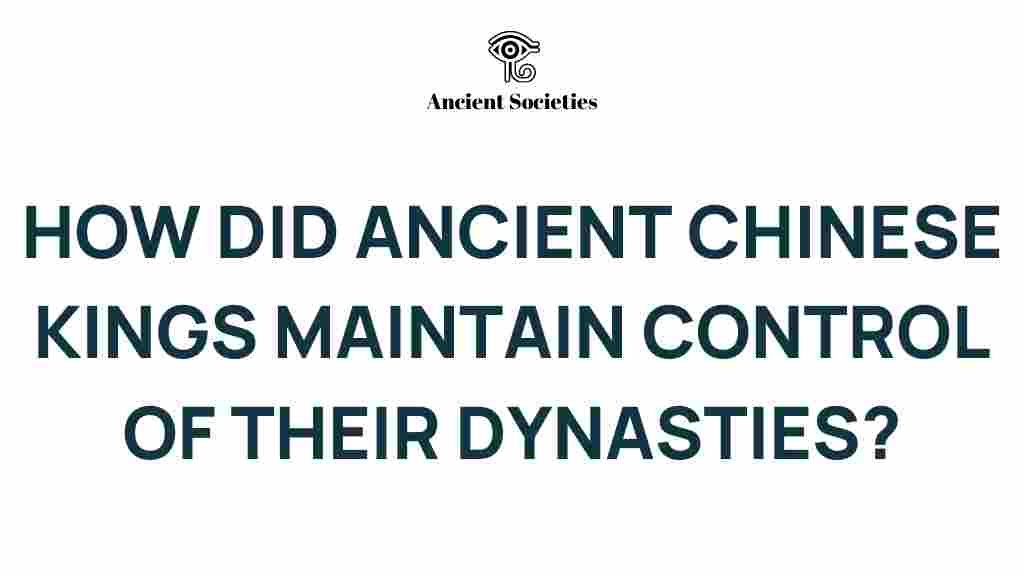Secrets of Ancient Chinese Kings: Mastering Dynasty Control
Ancient China is a fascinating tapestry woven with the threads of power, governance, and the intricate strategies employed by its rulers. The dynasties that rose and fell over millennia offer profound insights into how kings managed their realms, maintained control, and left a lasting legacy. This article explores the secrets of ancient Chinese kings, focusing on their governance strategies, the history of dynasties, and the dynamics of power that defined this remarkable civilization.
The Historical Context of Ancient Chinese Dynasties
To understand the secrets of ancient Chinese kings, one must first delve into the historical context of their dynasties. Ancient China is marked by several significant dynasties, each with its unique contributions to governance and power control. Key dynasties include:
- Shang Dynasty (c. 1600–1046 BC): Known for its advances in bronze metallurgy and writing.
- Zhou Dynasty (c. 1046–256 BC): Introduced the Mandate of Heaven, legitimizing rulers’ authority.
- Qin Dynasty (221–206 BC): Unified China and standardized many aspects of governance.
- Han Dynasty (206 BC–220 AD): Known for its cultural and technological advancements.
- Tang Dynasty (618–907 AD): A golden age of culture and trade.
- Song Dynasty (960–1279 AD): Notable for economic growth and innovation.
- Ming Dynasty (1368–1644 AD): Famous for its naval expeditions and cultural achievements.
- Qing Dynasty (1644–1912 AD): The last imperial dynasty of China, known for its expansion and consolidation.
Each of these dynasties employed unique strategies to maintain control over their vast territories and diverse populations. Understanding these strategies provides insight into the governance of ancient China.
Strategies for Dynasty Control
The kings of ancient China utilized several key strategies to maintain their power and control over their dynasties. Here are some of the most effective methods:
1. The Mandate of Heaven
The concept of the Mandate of Heaven was crucial for legitimizing a ruler’s authority. It was believed that heaven granted the emperor the right to rule, but this mandate could be revoked if the ruler became tyrannical or failed to govern wisely. This principle allowed ancient Chinese kings to:
- Justify their rule against challenges.
- Encourage moral governance and responsibility.
- Provide a framework for the transition of power during revolts or dynastic changes.
2. Centralized Bureaucracy
Ancient Chinese kings established a centralized bureaucratic system to manage their empires effectively. This system allowed for:
- Efficient tax collection and resource distribution.
- Implementation of laws and policies across vast territories.
- Control over local officials to prevent corruption and rebellion.
By appointing officials based on merit rather than aristocratic lineage, particularly during the Han Dynasty, rulers could enhance governance efficiency and loyalty.
3. Diplomacy and Alliances
Ancient kings often engaged in diplomatic efforts to secure their power. This included:
- Forming alliances through marriage with powerful families or other states.
- Creating trade agreements that benefited all parties involved.
- Employing skilled diplomats to negotiate peace and combat potential threats.
4. Military Power
Control over military forces was a hallmark of ancient Chinese governance. Kings maintained power through:
- Building a strong and loyal army.
- Implementing military reforms to improve effectiveness.
- Using military campaigns to expand territory and deter invasions.
The importance of military might was evident during the Qin Dynasty when legalism was emphasized to strengthen the state through strict laws and military discipline.
5. Cultural Integration
To maintain control over diverse populations, ancient Chinese rulers promoted cultural integration and unity. This was accomplished through:
- Standardization of language and writing systems.
- Promotion of Confucian ideals to foster social harmony and loyalty.
- Support for arts and education to enhance cultural identity.
Troubleshooting Governance Challenges
1. Rebellions and Uprisings
Rebellions were a recurring threat to dynasty stability. To counteract this:
- Rulers employed a combination of military force and negotiation to quell uprisings.
- They often instituted land reforms to appease the peasantry and reduce grievances.
- Creating a sense of shared identity and purpose among citizens helped unify the populace.
2. Corruption and Inefficiency
Corruption among officials could undermine a dynasty’s stability. Strategies to combat this included:
- Regular audits and inspections of local officials.
- Implementing strict penalties for corrupt practices.
- Encouraging public reporting of misconduct.
3. External Threats
Foreign invasions posed significant risks. Ancient kings often responded by:
- Fortifying borders and building defensive structures, such as the Great Wall.
- Forming alliances with neighboring states to create a united front.
- Investing in military technologies and strategies to enhance defense capabilities.
Conclusion
The secrets of ancient Chinese kings reveal a complex interplay of strategies aimed at mastering dynasty control. From the philosophical underpinnings of the Mandate of Heaven to the pragmatic approaches of centralized bureaucracy and military power, these rulers employed diverse tactics to maintain authority and stability. By understanding the history of dynasties and the governance techniques used by these kings, we gain valuable insights into the foundations of one of the world’s oldest civilizations.
For those curious to explore more about the fascinating history of ancient China, consider visiting this resource for further reading. Understanding the past helps us appreciate the complexities of governance and power that have shaped societies throughout history.
In summary, the governance strategies of ancient Chinese kings serve not only as historical lessons but also as timeless principles that can inform modern leadership and management practices. By learning from their experiences, contemporary rulers and leaders can navigate their challenges more effectively.
This article is in the category History and created by AncientSocieties Team
